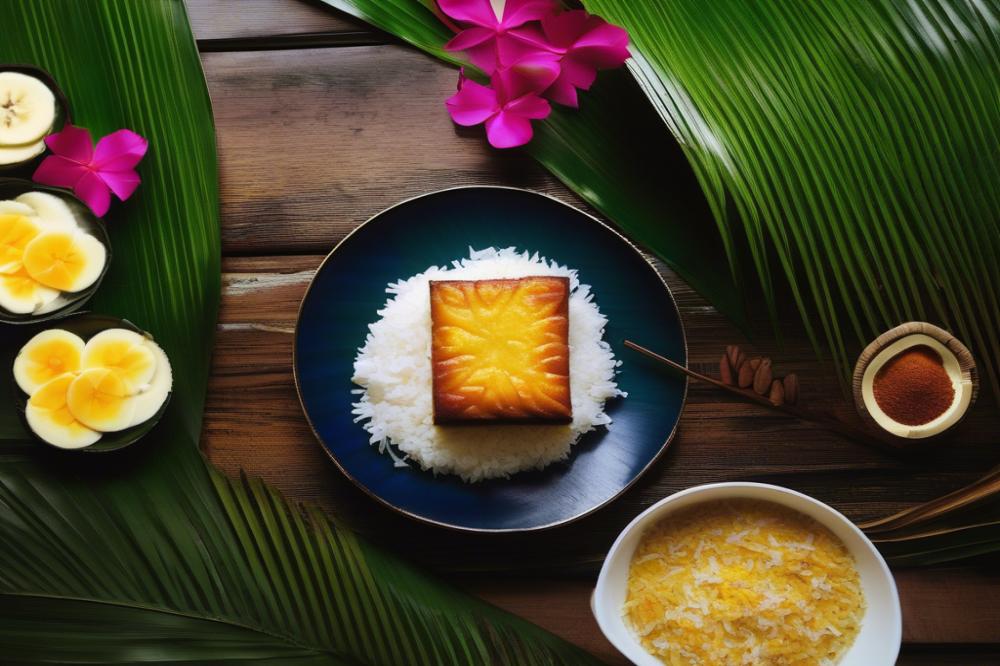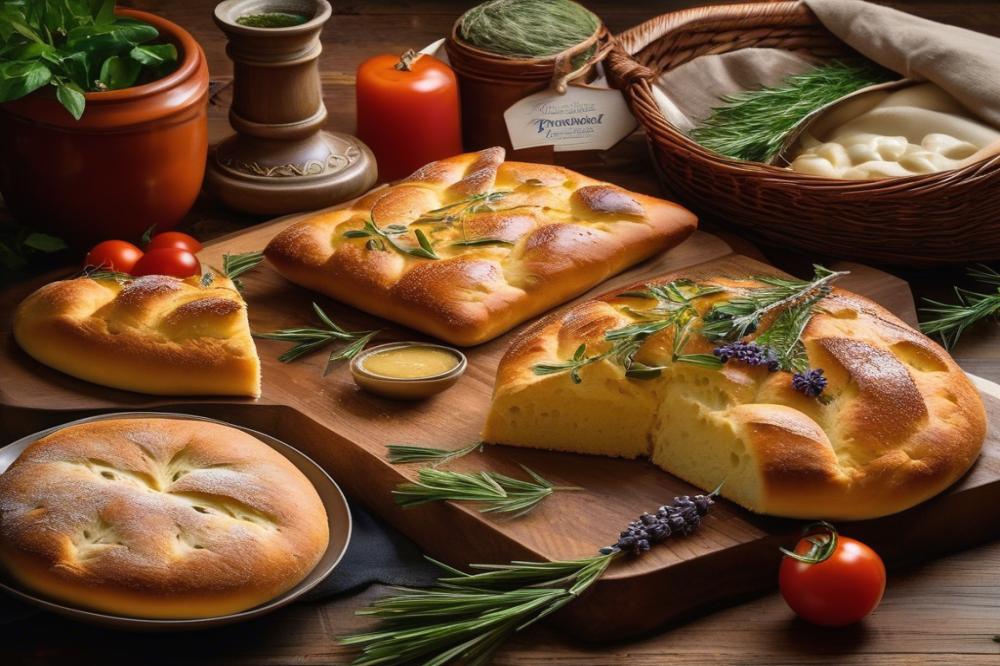Introduction
Bibingka is a beloved Filipino dessert that has become a cherished part of the country’s culinary heritage. This delightful dish is made primarily from rice flour and coconut milk, creating a unique flavor that many adore. Often enjoyed during the Christmas season, it is a popular holiday treat that brings families together. Street vendors and local bakeries make this festive food available throughout the festive weeks, filling the air with mouthwatering aromas.
The significance of this dessert goes beyond just its taste. Bibingka holds a special place in Filipino culture, especially during celebrations like Christmas and other local festivals. Traditionally, people gather to enjoy this sweet snack, symbolizing togetherness and joy. Embracing this cultural tradition can evoke warm memories for many. Sharing this food with friends and family creates lasting bonds.
Crafting this Coconut Rice Cake involves a traditional recipe passed down through generations. Ingredients such as rice flour and coconut milk play a vital role in creating its soft and chewy texture. Other components, like sugar and baking powder, enhance the flavor, making it delightful for any palate. The baking method often features clay pots lined with banana leaves, which impart an aromatic essence to the final product. This method is unique compared to typical baking practices, showcasing a blend of heritage and flavor.
Another interesting aspect of Bibingka is its versatility. While it is naturally a gluten-free dessert, creative variations exist, ensuring that everyone can enjoy this dish. Some people add different toppings like cheese, salted eggs, or even coconut shavings. These additions elevate the experience, sparking joy with every bite. Truly, this dessert reflects the essence of Southeast Asian cuisine and its rich cultural background.
What is Bibingka

Bibingka is a delicious Filipino dessert made from rice flour and coconut milk. It is often enjoyed during festive occasions and holidays. This traditional recipe has many variations throughout Southeast Asia. You might find similar rice cakes in Indonesia, Malaysia, and Thailand, each with its own twist. Variations can include different toppings or flavors, showcasing the local ingredients and culture.
The origins of this delightful treat can be traced back to the Philippines during the Spanish colonial period. Traditionally, it was cooked in clay pots lined with banana leaves. This method gave a distinct flavor fused with the sweetness of coconut. Today, bibingka is commonly associated with the Christmas season. Families prepare it to celebrate the holiday spirit. This gluten-free dessert continues to bring people together through shared recipes and community traditions.
Comparing bibingka with other traditional rice cakes in Southeast Asia reveals many fascinating similarities and differences. For instance, in Thailand, you might encounter a cake called khao tom mud, made with sticky rice and wrapped in banana leaves. This treat is typically sweeter but does not have the same texture as bibingka. In Indonesia, there is kue cubir, which offers a unique flavor using different ingredients. Both of these desserts highlight local tastes and customs. Despite their differences, they all celebrate the use of rice as a fundamental ingredient in Southeast Asian cuisine and traditional food culture.
People enjoy bibingka not only as a holiday treat but also as an everyday sweet snack. With its fluffy texture and rich coconut flavor, this cake truly stands out. The bibingka recipe varies from family to family, making each version special. It’s a dish that represents much more than just food; it carries with it heartfelt stories, memories, and tradition.
Key Ingredients

To create a delicious Filipino dessert like bibingka, several crucial components work together to bring out its unique flavor and texture. Each ingredient plays a fundamental role in ensuring the final product is delightful and satisfying.
Rice Flour
This is the backbone of the recipe. Made from finely milled rice, rice flour is essential for giving the cake its structure. It helps to create a dense, yet soft texture that is characteristic of this traditional recipe. Using rice flour makes the dessert gluten-free, appealing to those with dietary restrictions. A quality rice flour can greatly influence the overall outcome.
Coconut Milk
Coconut milk adds a rich, creamy consistency that enhances the cake’s flavor. It infuses each bite with a subtle sweetness that is distinctive to Southeast Asian cuisine. The fat content from coconut milk contributes to the moistness of the bibingka, making it a truly irresistible holiday treat. Without this ingredient, the dessert would lose its creamy character.
Sugar, Baking Powder, and Salt
For the perfect balance, sugar is used to sweeten the rice cake. It works hand in hand with the coconut milk, providing a flavor profile that many enjoy. Baking powder is a leavening agent that helps the dessert rise, creating a light and airy texture that contrasts nicely with its base. Salt is used sparingly, yet it acts as a flavor enhancer, bringing all the elements together in harmony.
Toppings and Their Significance
Common toppings include grated coconut or cheese, which can offer additional flavors and textures. A sprinkle of sugar on top can create a sweet crust that many people find appealing. These sweet snacks are often enjoyed warm, straight from the oven, further highlighting the importance of these additions.
The Importance of Quality Ingredients
Selecting high-quality ingredients is paramount for achieving the best results. Fresh coconut milk makes a noticeable difference in taste, while premium rice flour will affect the texture of the bibingka. When each component is chosen with care, the dessert transforms into a delightful celebration of flavors and textures, making it a standout dish during festivities.
Bibingka Recipe

Discover the joy of making bibingka, a delightful Filipino dessert, that is often enjoyed during the holidays. This traditional recipe highlights the rich flavors of Southeast Asian cuisine.
Ingredients
- 1 ½ cups rice flour
- 1 cup coconut milk
- ½ cup sugar
- 2 eggs
- 1 tablespoon baking powder
- ½ teaspoon salt
- 1 tablespoon melted butter
- Banana leaves, for lining the baking pan
Step-by-Step Instructions
Start by preheating your oven to 375°F (190°C). While that heats up, rinse banana leaves in hot water to make them pliable. Line a round baking pan with the banana leaves. This adds flavor and prevents sticking.
Combine rice flour, sugar, baking powder, and salt in a large bowl. Use a whisk to mix these dry ingredients thoroughly. In a separate bowl, beat the eggs and mix in the coconut milk and melted butter. Gradually add the wet ingredients to the dry mixture. Stir well until everything is smoothly combined.
Pour the batter into your prepared baking pan. Bake for about 30 to 35 minutes, or until the top is golden brown. Checking for doneness is easy. Insert a toothpick into the center. If it comes out clean, your bibingka is ready!
Baking Method
For the best texture, allow the batter to rest for about 15 minutes before baking. This helps the rice flour absorb moisture. Using a proper baking pan is essential. A round, shallow pan tends to work best for achieving that perfect fluffy consistency.
Variations of the Recipe
Common variations of bibingka include toppings that elevate its flavor. You might prefer a slice of salted egg or some cheese sprinkled on top before baking. Grated coconut serves as another delicious option. Enjoying these toppings gives each bite a burst of flavor, making it truly festive.
Don’t hesitate to experiment with fruits too! Adding sweet slices of mango or a drizzle of caramel can create a unique twist. This flexibility makes bibingka a beloved holiday treat as well as a versatile dessert to enjoy all year round.
Bibingka as a Festive Food
Bibingka is more than just a dessert; it is a symbol of celebration in the Philippines. During the holiday season, this rice cake comes alive with flavor and tradition. Families gather to prepare this delectable treat, which is usually made with rice flour and coconut milk. The smell of bibingka baking fills the air, creating a warm atmosphere that invites everyone in.
Christmas is a special time for enjoying this festive food. Street vendors sell it at numerous markets, filling the streets with enticing aromas. It is common for people to buy bibingka after attending a midnight Mass. This tradition adds to the excitement of the season, as people share their sweet snacks with family and friends. Fiestas also highlight its role in Filipino culture. During these gatherings, bibingka takes center stage among a variety of traditional recipes, showcasing local flavors.
Preparing this gluten-free dessert brings families closer together. Each household often has its own special bibingka recipe passed down through generations. The process of mixing ingredients and cooking together strengthens bonds. Sharing the finished product enhances the joy of the occasion. It is not just about food; it’s about connection and heritage.
Serving bibingka to guests reflects hospitality and warmth. Traditionally, it is enjoyed with butter or sugar on top, making it even more delightful. This unique dish stands as a testament to the rich traditions of Southeast Asian cuisine. Families eagerly anticipate this holiday treat, making it a significant part of their celebrations each year.
Bibingka as a Gluten-free Dessert
For dessert lovers searching for a gluten-free option, bibingka offers an appealing choice. This traditional Filipino dessert is made from rice flour, making it suitable for those with gluten sensitivities. Many people enjoy it as a festive food during special occasions, especially during the holidays. The delightful combination of flavors creates a unique treat that delights the taste buds.
Using rice flour and coconut milk in crafting this sweet snack provides several health benefits. Rice flour is naturally gluten-free and can be easier to digest for some individuals. Coconut milk adds a rich, creamy texture and contributes to the overall flavor profile. In addition to being delicious, these ingredients often provide essential nutrients and can contribute positively to one’s diet.
When serving bibingka, it’s helpful to think about various dietary preferences. People can enjoy a classic recipe, but the dish can also be adapted. For those who prefer different flavors, consider adding toppings like cheese or salted eggs. Various variations can cater to vegan diets, by substituting dairy ingredients. Offering this sweet snack with different options ensures everyone can partake.
Moreover, presenting bibingka with fresh fruits or a dusting of sugar can also elevate the experience. Whether shared at a festive gathering or enjoyed any time, this Southeast Asian cuisine gem brings joy. Its natural sweetness makes it a favorite as a holiday treat. The dish captures the essence of Filipino culture and hospitality.
Final Thoughts on Bibingka
Significance in Filipino Cuisine
Bibingka holds a cherished place in Filipino cuisine. This beloved Coconut Rice Cake is often associated with the holiday season and various celebrations. Families gather, sharing this delightful treat that connects them to their heritage. It embodies warmth and togetherness. During special occasions, the aroma of Bibingka wafts through homes, inviting everyone to partake in its deliciousness.
Make It at Home
Trying your hand at making this culinary delight can be a fulfilling experience. With the right ingredients like rice flour, coconut milk, and sugar, the process becomes an exciting adventure. Following the recipe you have, you can create your own version of this delicious Filipino dessert. Don’t hesitate to experiment and add your twists as you discover what works best for you.
Cultural and Festive Importance
This coconut rice cake is more than just a tasty treat; it symbolizes tradition and festivity. Enjoying it during special times reminds Filipinos of their cultural roots. The simple yet satisfying flavors capture the heart of Filipino cooking. Whether served warm with toppings or shared among friends and family, Bibingka continues to be a centerpiece during festive occasions. Embrace the joy it brings and consider adding this culinary gem to your own celebrations.



